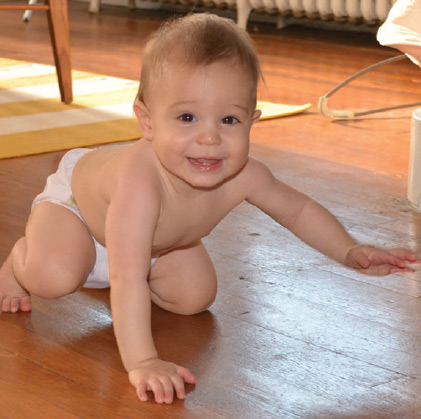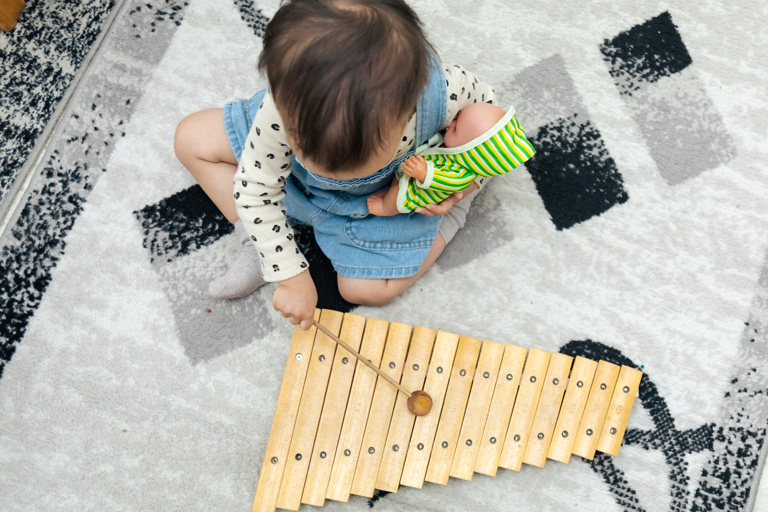
Developing Neck and Upper Body Strength
August 16, 2019
Babbling, the Milestone Few Talk About
October 14, 2019By TEIS Early Intervention Staff
Crawling – Your Baby’s Amazing Superpower
Building Skills and Healthy Bodies
For your baby, crawling is much more than a way to get around on hands and knees. It’s a superpower that helps introduce her to the world, building skills and self-awareness in beneficial ways.
For scientists studying early development, the simple activity of crawling is full of surprises. Crawling helps develop both coordination and environmental curiosity. With this simple, safe movement, your baby is developing a physical understanding of the world and their relationship to it.
Visual skills grow quickly as your child looks ahead to focus on a desired toy or destination, then back to his or her hands to make sure their immediate path is clear. This in an exercise in binocular vision, strengthening the skills one day needed to catch a ball or drive a car.
Self-confidence is another non-obvious benefit of crawling. While crawling may seem aimless to adults, your child is learning spatial strategies and facing real world obstacles. That pillow or playpen in the way represents a learning opportunity and, over time, your baby becomes confident and efficient in crawling — perhaps going over or through some hurdles and around more difficult ones.
Stay Aware and Keep Crawling Safe
Your baby is counting on you to keep them safe. He or she may turn often at first to keep you in sight. Your facial expressions, words of encouragement, and restrictions when necessary are an important part of the process. Of course, you also want to be there and aware, keeping baby safe.
Many babies begin to crawl between 7 and 10 months of age. When you take on the job crawling coach, you can help in a variety of ways:
- To orient your child to crawling, place him or her tummy down over your thigh or lower leg. Rock them back and forth and side to side.
- Provide some assistance by gently moving their legs opposite of arms.
- Place their favorite toys just out of reach so they need to crawl towards them.
- Have your child crawl over pillows and easy obstacles.
- Place a towel under baby’s tummy and lift them off floor to move from army/combat crawling to hands and knees crawling.
- Advanced crawling could be an adventure on stairs or through a play tunnel.
The Physical and Neurological Benefits of Crawling
Perhaps the most obvious thing about crawling is that it provides good exercise and helps with physical development. Crawling builds core strength and shoulder stability. Both hip alignment and motor skills are improved in crawling.
While crawling, your baby is developing gross skills and fine motor skills, including improved hand-eye coordination.
Crawling is one of the first times in life when we use reciprocal motion, and perhaps the only time we engage in reciprocal, alternate movements of both arms and legs. We’re all familiar with the rhythmic, reciprocal motion of pedaling a bike or pulling a rope hand over hand. In crawling, this alternating movement of arms and legs not only helps your baby cross the floor, it makes neurological signals cross the corpus collosum in your baby’s brain, creating a well paved highway so the brain can work efficiently as your child grows older.
Because crawling is a weight bearing exercise, it helps to properly form the horizontal and vertical arches in your baby’s hands, and this in turn aids with the development of fine motor skills as the child grows older.
Babies who crawl can learn posture and balance skills that help provide for early walking.
Is Baby Doing It Right?
Crawling is a part of your baby’s engagement with the world and learning how to use his or her own body, so they may put their own spin on it. Ranges of normal behavior includes belly-crawling, hands-and-knees crawling, bottom shuffling (scooting), rolling, and a hands-and-feet motion.
Crawling on hands and knees is to be encouraged, because it is the most effective method for delivering all the benefits discussed in this article.
Of course, your baby may combine techniques or shift through a range of motions. As long as your baby is engaged, experimenting, and making progress, her crawling is right on track. By 12 months, if you believe your baby is making no progress in crawling, or shows weakness or poor control on one side of the body, then you should talk to your pediatrician.
Do you have questions about the development of crawling behavior? Call TEIS Early Intervention at 412-271-8347 or Text INFO to 412-543-8398 During Regular Business Hours (8:00 am to 4:00 pm, M-F).
Reference Links for More Information
TEIS Early Intervention | Don’t Let Your Baby Skip Crawling
Day2Day Parenting | Benefits of Crawling
Parenting Science | When Do Babies Crawl, and How Does Crawling Develop?





